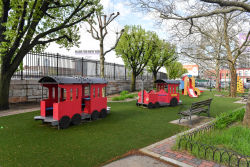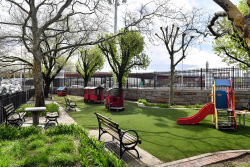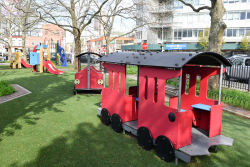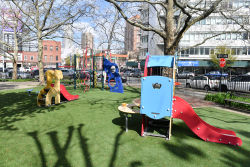Old Hickory Playground
Old Hickory Park
What was here before?
This was once the estate of John Horan, who served as Treasurer and Receiver of Taxes for Long Island City from 1871 to 1876. In 1875, a cash deficit revealed his misappropriation of city funds, leading to his arrest. His son, John Joseph Horan (1866–1900), was a New York–born engineer educated at Cooper Union, with a career spanning the U.S., Brazil, and England. Known for his mechanical inventions, he worked on chemical plants, petroleum refineries, and New York’s Catskill Aqueduct.
How did this site become a park?
The Queens-Midtown Tunnel, designed by engineer Ole Singstad, was completed in 1940 after four years of construction. This double-tube tunnel spans 6,300 feet and features computer-controlled ventilation towers that refresh the air every 90 seconds. In 1941, the area above the tunnel was transformed into the Queens Plaza Sitting Area, now, the Old Hickory Playground.
Old Hickory Playground was designed especially for toddlers and young children. The playground includes ground-level equipment such as gentle slides and two bright red train cars, encouraging both physical activity and imaginative play. Its compact layout allows caregivers to easily supervise children, while landscaping elements like planting beds and a low fence create a green, secure, and peaceful environment. A highlight of the playground is its wheelchair accessible entrance, supporting inclusive play for all children.
What is this park named for?
Andrew “Old Hickory” Jackson (1767–1845), the seventh U.S. president, earned his nickname for his toughness and determination. As a militia leader, he once refused orders to disband his troops in the wilderness, instead pledging his own funds for supplies and marching home alongside them.
Born in the Waxhaws on the North–South Carolina border to Irish immigrants, Jackson was orphaned during the Revolutionary War, served as a teenage soldier and was captured by the British. He became a lawyer in the Tennessee frontier and married Rachel Donelson Robards in 1794, though a sense of scandal always surrounded their relationship since she didn’t properly divorce her first husband before cohabitating.
Jackson’s rise to national prominence came through both politics and military victories, most famously his win at the Battle of New Orleans in 1815. In 1804, he purchased his cotton plantation, the Hermitage, which relied on the forced labor of enslaved persons. Over his lifetime, Jackson enslaved dozens of men, women, and children, profiting from their labor. As president, he defended slavery as vital to the nation’s economy and stability, condemning abolitionist efforts.
Jackson first ran for president in 1824, and despite winning the popular majority he did not obtain enough Electoral College votes to win the four-way race. The House of Representatives chose John Quincy Adams to serve. Elected president in 1828, Jackson portrayed himself as a champion of the “common man,” opposing institutions like the Bank of the United States and replacing many government officials with his personal and political allies. The adage “To the victor belong the spoils” seemed to fit this Jacksonian philosophy, and this practice of political favors has been called a “spoils system” ever since.
Jackson’s opponents had justification for the epithet “King Andrew I” for the authoritarian measures he took. In the South Carolina tariff dispute, known as the Nullification Crisis, he asserted federal authority by threatening military action to enforce tax collection against a defiant state government. He also enforced the Indian Removal Act, which forced Native American nations to surrender their ancestral homelands and relocate west of the Mississippi River. This policy led to the “Trail of Tears,” during which thousands of Cherokee, Creek, Choctaw, Chickasaw, and Seminole people died from exposure, disease, and starvation.
Jackson retired to the Hermitage in 1836, where enslaved people continued to labor for him until his death in 1845. His legacy combines populist appeal with policies rooted in racial exclusion, displacement, and the expansion of slavery.
Check out your park's Vital Signs
Clean & Safe
Green & Resilient
Empowered & Engaged Users
Share your feedback or learn more about how this park is part of a
Vital Park System




